
Izatha prasophyta is a moth of the family Oecophoridae. It is endemic to New Zealand, where it is known from the North Island, except Hawkes Bay or the Wairarapa. Larvae likely feed on rotting wood although larvae of this species have been reared on the fruiting body of the bracket fungus Bjerkandera adusta. Adults are on the wing from November to February.

Izatha caustopa is a lichen tuft moth in the family Oecophoridae. It is endemic to New Zealand, where it is known very locally, and very infrequently, from the southern half of the North Island: two specimens collected in 2016 were the first seen for 30 years. It is classified as "Data Deficient" by the Department of Conservation.
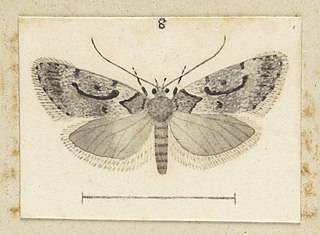
Izatha manubriata is a moth of the family Oecophoridae. It is endemic to New Zealand, where it is known from the southern South Island only.

Izatha rigescens is a species of moth in the family Oecophoridae. It is endemic to New Zealand. This species is classified as having the conservation status of "Data Deficient" by the Department of Conservation. It is only known from the Wellington coast. This species has not been seen since 1929.
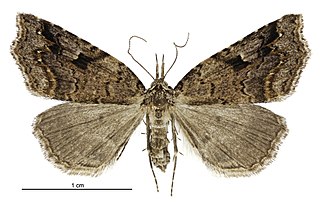
Trigonistis anticlina is a species of moth in the family Noctuidae. It is endemic to New Zealand. Adults of this species inhabit dense native forest habitat in ravines.

Chersadaula ochrogastra is a species of moth in the family Oecophoridae. This species is endemic to New Zealand. It is classified as "Data Deficient" by the Department of Conservation.

Trachypepla semilauta is a moth of the family Oecophoridae and was first described by Alfred Philpott in 1918. It is endemic to New Zealand and has been collected in Southland. This species inhabits southern beech forest on the side of mountains. Adults are on the wing in January.
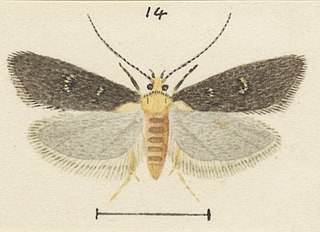
Trachypepla cyphonias is a species of moth in the family Oecophoridae. It is endemic to New Zealand and has been collected in Wellington and Taranaki. Larvae of this species have been reared from kānuka leaf litter. Adults are on the wing in December. This species is classified as "At Risk, Naturally Uncommon" by the Department of Conservation.

Tingena ancogramma is a species of moth in the family Oecophoridae. It is endemic to New Zealand and has been found in the Hen and Chicken Islands, the North Island and the South Island. Adults are on the wing in summer and autumn and inhabit open areas of forest scrubland.

Tingena chloradelpha is a species of moth in the family Oecophoridae. It is endemic to New Zealand and can be found in the North and South Islands. The larvae live underground forming silken tubes from which it feeds. It overwinters in these tubes and then pupates enclosed in a weak pale white silken cocoon. The adults of this species is variable in appearance both in the depth of colour as well as in its discal spots which may in some specimens be lacking. The adults are on the wing from October until the end of December and can be found inhabiting domestic gardens as well as cultivated land. They have been seen resting on window frames and can be found inside houses.
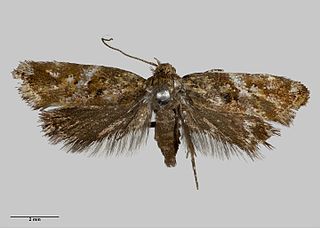
Tingena eumenopa is a species of moth in the family Oecophoridae. It is endemic to New Zealand and found in the North and South Islands. The adults have been found amongst tree ferns and are on the wing in December.

Tingena idiogama is a species of moth in the family Oecophoridae. It is endemic to New Zealand and has been observed on the slopes of Mount Taranaki. Its preferred habitat is native subalpine scrub and adults are on the wing in January.
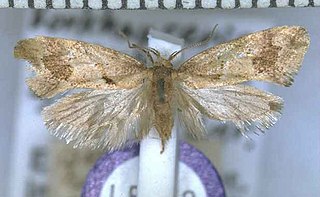
Tingena penthalea is a species of moth in the family Oecophoridae. It is endemic to New Zealand and has been observed in Wellington and the Tararua Range. The adults of this species are on the wing from December until February.

Asaphodes prymnaea is a moth in the family Geometridae. It is endemic to New Zealand and can be found on the Mount Arthur tableland. It is common in limestone valleys. The female of the species is paler and has less distinctive markings than the male. Adults are on the wing in January and February.

Atomotricha exsomnis is a moth in the family Oecophoridae. It was first described by Edward Meyrick in 1913. It is endemic to New Zealand and can be found in both the North and South Islands. Adults are on the wing from November until January.

Atomotricha isogama is a moth in the family Oecophoridae. It was first described by Edward Meyrick in 1909. This species is endemic to New Zealand and has been observed in the North and South Islands. Larvae are leaf litter feeders and have been recorded as emerging in the New Zealand spring. Adults have been observed on the wing from July to January.

Atomotricha oeconoma is a moth in the family Oecophoridae first described by Edward Meyrick in 1914. It is endemic to New Zealand and has been observed at Mount Taranaki, Wellington and in Dunedin. The adults emerge in June. The female adult is semi-apterous and is incapable of flight.
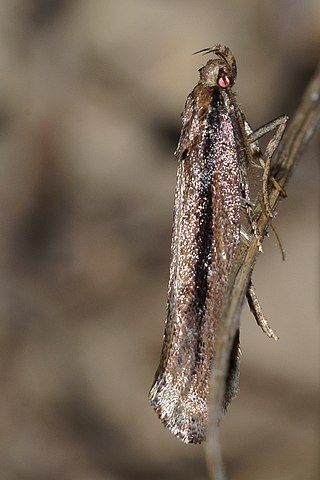
Atomotricha versuta is a moth in the family Oecophoridae first described by Edward Meyrick in 1914. It is endemic to New Zealand and has been observed in both the North and South Islands. The adults of the species are variable in appearance but the three principal variteis are connected b intermediate forms. The female of the species is brachypterous and is incapable of flight. Both the adult male and female have been observed resting on fences during cold winter nights.

Trachypepla importuna is a moth of the family Oecophoridae first described by Edward Meyrick in 1914. It is endemic to New Zealand. Adults have been collected in the North Island in January but the species is regarded as being poorly known.

Trachypepla photinella is a moth of the family Oecophoridae first described by Edward Meyrick in 1883. It is endemic to New Zealand and has been collected in Wellington, Wainuiomata, D'Urville Island and Christchurch. The preferred habitat of this species is native forest and adults are on the wing from December until February.




















